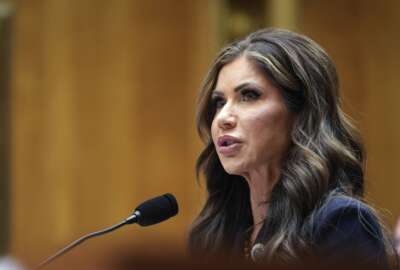Agencies engage citizens with social collaboration
Agencies across the federal government are embracing the tools of social collaboration to become more accessible to citizens. An IT industry group that includes...
wfedstaff | June 3, 2015 12:52 am
By Max Cacas
Reporter
Federal News Radio
With a mandate from the White House to make the government more open and transparent, especially to citizens, federal agencies are increasingly turning to the tools of social collaboration, and doing it in a way that fits the mission of the organization.
On Thursday, The Association for Federal Information Resources Management, better known as AFFIRM, devoted its April lunch meeting to a discussion of putting citizens at the center of government. Yesterday’s panel discussion in the Marvin Center at George Washington University was moderated by Dave McClure, Associate Administrator at the General Servces Administration.
As the person leading citizen engagement at GSA, I recognize how important it is for us in our agencies, to get out message out effectively, to get engagement right, to get participation right.
Janice Nall is Director of the Division of E-health Marketing with the National Center for Health Marketing at the Centers for Disease Control and Prevention in Atlanta. Now working on temporary detail to the GSA, she heads up a section on the CDC website devoted to health information.
Speaking of the web, and especially many of the popular social collaboration sites, Nall told her audience, “if people are getting their information out in the social atmosphere, that’s where we have to be. If they’re getting information about STDs (sexually transmitted diseases) in Second Life, if they’re talking about quitting smoking on mobile phones, if they’re in blogs talking about vaccinations for their kids, that’s where we have to be. It’s where the commercial entities are, and we have to be there too as government. Not with a regurgitation of all our information verbatim top to bottom, but with with the salient points, and then bringing people back to the ‘mothership,’ the website, if they want more information in detail.”
Amanda Eamich is Director of New Media for the Agriculture Department. She told the AFFIRM lunch crowd about “Apps for Healthy Kids”, a contest now underway to engage children and adults to help develop software tools on the web to promote better eating habits.
Apps for Healthy Kids is based on a dataset we released last December on Data.gov, which is the thousand most common foods, and their nutritional values. The idea is that we target the audience of “tweens”, especially, and parents, the nutritional gatekeepers, to develop games and apps for those audiences.
Eamich says the USDA brought in gaming experts, entertainment experts, and those in the nutrition field to help design the contest. Eamich says the “Apps for Healthy Kids” contest continues on the USDA website through this summer, so schools can integrate the program in their healthy eating classes.
And then, the AFFIRM luncheon heard from Liz Olmo, Director of Strategic Requirements, Capabilities and Assessment with the Office of Policy and Strategic Planning, with the Department of Homeland Security.
“I’m not an expert. I have a deep secret. I don’t have a Twitter account. Never used one. No one in our shop is IT oriented. I’m a policy analyst!”
And with that self-deprecating introduction, Olmo proceeded to describe her experience being part of the team that conducted one of the most groundbreaking efforts in citizen engagement on behalf of a federal agency that was re-assessing its policies and programs top to bottom: the Quadrennial Homeland Security Review. In 2008, Congress mandated that DHS begin conducting top-to-bottom reviews of agency policies and procedures every four years, as is done at the Pentagon and State Department.
“We were given a mandate by Congress to engage our stakeholders,” she explained, saying that the list includes the 22 agencies that make up DHS, the Department of Justice, Commerce, the Pentagon, state and local officials, including governors, firefighters, police and sheriffs, academics and the public.
Olmo says internally, three different strategies for conducting the review were considered and then thrown out. Instead, DHS got help from the National Academy of Public Administration, a D.C.-based “good government” non-profit think tank.
NAPA encouraged DHS to conduct the fact-and-opinion gathering stage of the QHSR as a three-phase “wiki” in which stakeholders were invited to participate directly in three “dialogues” – proposing, commenting on, and refining recommendations – that eventually ended up in the QHSR final report.
“We actually gave ourselves a lot of pain by doing three dialogues,” she said, adding, “That’s how we got to transparency with our stakeholders. They saw us change. They saw us change our minds, they saw us change our content, and they felt like they were actually engaged. ”
Olmo acknowledged that they “didn’t get it right the first time. We had a very limited amount of content. But what we did do was learn. We kept iterating, and listening to our people, and we changed, and we got a lot of comments on that, and we kept getting better and that’s okay. It’s important for us as government folk to understand we won’t get it perfect the first time, and that’s fine. Just learn from it and keep changing, and the public was with us, and it was wonderful!”
The Quadrennial Homeland Security Review was delivered to DHS and President Obama earlier this year.
(Copyright 2010 by FederalNewsRadio.com. All Rights Reserved.)
Copyright © 2025 Federal News Network. All rights reserved. This website is not intended for users located within the European Economic Area.





